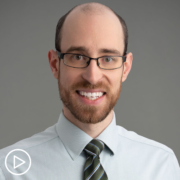Emerging Waldenström Macroglobulinemia Treatment Approaches
Emerging Waldenström Macroglobulinemia Treatment Approaches from Patient Empowerment Network on Vimeo.
What Waldenström macroglobulinemia (WM) therapies are showing promise? Dr. Jorge Castillo of the Dana-Farber Cancer Institute discusses emerging research and advances in WM treatment.
Dr. Jorge Castillo is Clinical Director at the Bing Center for Waldenström Macroglobulinemia Dana-Farber Cancer Institute and Assistant Professor of Medicine at Harvard Medical School. Learn more about Dr. Castillo, here.
See More From The Pro-Active Waldenström Macroglobulinemia Patient Toolkit
Related Programs:

What Are the Treatment Goals for Waldenström Macroglobulinemia? |

|

Factors That Affect Waldenström Macroglobulinemia Treatment Decisions |
Transcript:
Katherine:
Dr. Castillo, are there emerging approaches for treating Waldenstrom’s?
Dr. Castillo:
Always. And that’s the beauty – that’s the second part of when we talked about clinical trials, right, we talked about clinical trials? Science continues, and we work very closely with an organization called the International Waldenstrom’s Foundation, and they support research all over the world for Waldenstrom’s.
So, their message is since the sun comes up until the sun comes down, there is someone, somewhere in the world working on Waldenstrom’s, and that’s true.
So, there’s a lot of science in the background, and that science helps us understand how the Waldenstrom’s cells behave, and therefore, we can then start targeting some things. That’s how BTK inhibitors came out. That’s how proteasome inhibitors came out. That’s how BCL-2 inhibitors came out. All these are the result of science, applied into the treatments. So, at my institution and many other institutions in the country and outside of the country, there are newer treatments being tried all the time.
We have now – we are looking into combining BTK inhibitors with other agents. Germany is doing a number of different studies. Canada is doing a number of different studies. We are doing some studies in the United States as well, combining chemotherapy and PIs with the BTK inhibitors. We’re doing a study in my institution combining BTK inhibitors with BCL-2 inhibitors. So, and the idea is to try to create a more powerful agent or regimen and hopefully maybe not give patients indefinite treatments, more like fixed duration treatments.
So, I think that’s where it’s coming. It’s coming maybe double, triple combinations, fixed duration treatments. That’s what is coming in terms of that aspect of the research. And then, we do have newer compounds coming out.
We do have now some concepts in what we call immunotherapy, right? We think about antibodies.
We think about bispecific T-cell engagers. CAR-T cells, so all that is actually up and coming in Waldenstrom’s. There are actual clinical trials being done today evaluating all those different treatments for patients with Waldenstrom’s.
So, I think the future is really bright. I’m really optimistic, to be honest with you about the treatment of patients with Waldenstrom’s. Obviously, what we need, what we want, is cure of the disease. And again, we can think about cure in two different ways. We can think about the classic definition of cure in which we treat patients, the disease goes away, you stop treatments, and the disease never comes back, right? That’s one way of looking at cure.
The other way of looking at cure is you treat the disease, the disease is in a remission, you continue treating the patient, and then the patient basically dies of other reasons, right? That is a functional cure. So, I think we’re closer to the latter, much more than the former, but the efforts to continue developing new treatments, it’s not stopping anytime soon.
Katherine:
No, because we’re always constantly moving forward, having to find new treatments, definitely.










